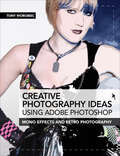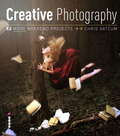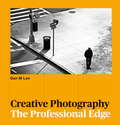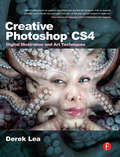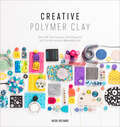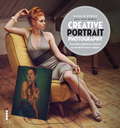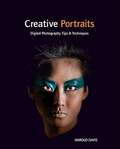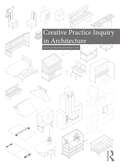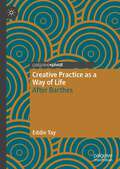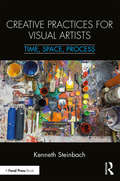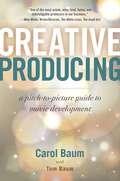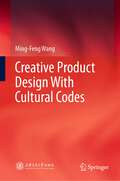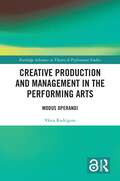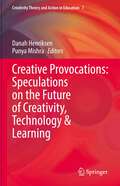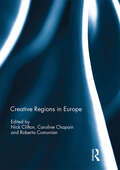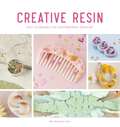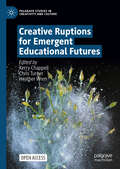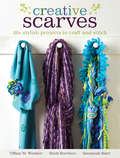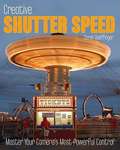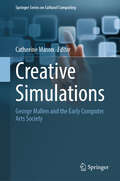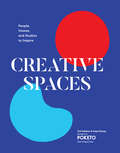- Table View
- List View
Creative Photography Ideas: Mono Effects and Retro Photography
by Tony WorobiecMono effects and retro photography is an excerpt from Creative Photography Ideas Using Photoshop which presents 75 comprehensive workshops that have been specifically designed for photographers; each offers a clever and creative technique that can be immediately applied.Mono effects and retro photography workshops focus specifically on mono effects such as sepia toning, lith effects, and selective colouring, as well as creating retro photography effects such as pinhole camera, adding borders, and disressing images.Each workshop offers ingenious creative techniques to immediately enhance images in Adobe Photoshop.From basic techniques to more advanced, all guidance is ‘best practice’ and shown via clear explanatory texts, photographs, ‘before, during and after’ manipulations and screen grabs.
Creative Photography: 52 More Weekend Projects
by Chris GatcumExperiment with new projects and techniques, and create arresting images time and again Digital cameras have made it easy for us all to take photos that are, technically, perfect: clearly exposed, sharply focused, and beautifully composed. However, what most photographers want from their photography is something more personal, more individual - in short, more creative. In this sequel to the highly successful Creative Digital Photography: 52 Weekend Projects, respected author and prize-winning photographer Chris Gatcum will show you how to create images that pack that creative punch and involve fun.
Creative Photography: The Professional Edge
by Adam Juniper Dan LeeTo earn a living these days, your photography has to rise above a lot of noise, so you need all the advantages you can get. Here, Dan M. Lee gives you back-to-back hard-hitting ideas that are proven to make every shot in your portfolio a stand-out image that grabs attention and wins new clients.Clients recognize and reward creativity. It's not enough to be competent with a camera: you need to experiment, find new perspectives, and innovate your workflow if you want to stay competitive. Whether that's using drones for aerial viewpoints, or creating perfect 360-degree real-estate images, this book gives you the edge you need to make it as a professional photographer.
Creative Photoshop CS4: Digital Illustration and Art Techniques
by Derek LeaIf you are a digital artist, illustrator, cartoonist, graphic artist, designer, or serious hobbyist looking for new and interesting ways to use Photoshop, this is the book for you! You already know how to use Photoshop as an image editing tool; now, challenge yourself and discover the more artistic aspects of the program with one of the world's best teachers by your side. In addition to four brand new chapters on real world projects, this new edition of award-winning digital artist Derek Lea's bestselling Creative Photoshop contains several brand new features such as "What you'll learn in this chapter" summaries, so you can quickly find projects using the specific tools you'd like to focus on, and supplementary information at the end of each chapter, containing useful resources and additional gallery images to provide further study and inspiration. As you work through Derek's fantastic artistic methods, be sure to visit www.creativephotoshopthebook.com for more information, including the project files for each chapter, available for download for you to work with, a reader forum, and more.
Creative Polymer Clay: Over 30 Techniques and Projects for Contemporary Wearable Art
by Heidi HelyardDiscover a world of inspired and colourful jewellery-making from the comfort of your own home. Just make, bake and wear! In this comprehensive guide to modern polymer clay techniques, artist and designer Heidi Helyard reveals the simple techniques that can be used to create one-off, contemporary jewellery pieces with minimal tools and equipment. Polymer clay, which has been around for nearly eighty years, is currently finding itself popular amongst contemporary jewellery makers as the bright colours and sheer versatility of the material allows makers to create bold and graphic modern designs. The beauty of polymer clay is that it presents so many opportunities to explore colour combinations, patterns and texture. In this book you will learn ten easy yet exciting techniques including slab and cane making, marbling and colour mixing, inlay techniques, printing onto clay, surface embellishments and more to create twenty unique jewellery pieces. The projects in this book vary in complexity, but are accessible to both novice and advanced makers alike. If you are a beginner, the extensive step-by-step photos and instructions will help you develop your polymer clay skills and complete the projects with confidence. As you build your skills and learn the techniques via the book, you will realise that you can combine techniques to create all-new results. The skills you learn in this book will open up a limitless world of further experimentation for you to discover.
Creative Portrait Photography: Innovative Digital Portraiture To Reveal The Inner Subject
by Natalie DybiszEdgy, evocative portraits and unique post-processing details make this the most creative, hip portrait book available. It goes beyond the technical aspects of lighting and posing (though they are well covered) and reveals how to capture the essence of your subject's true inner self. Acclaimed photographer Natalie Dybisz offers advice on building trust, planning shoots, directing people, and using digital tools such as post-editing and compositing to create great portraits. An extensive showcase chapter presents several artists' works and methods.
Creative Portrait Photography: Innovative Digital Portraiture To Reveal The Inner Subject
by Natalie DybiszThe very best portrait photography strives to give the viewer access into their subject's inner self; to provide a window into their soul. With the advent of the digital age and the potential afforded by post-processing, a whole generation of photographic artists has access to greater creative possibilities than ever before.Spearheading this new breed of creative photographer is author Natalie Dybisz, better known in the photographic community as Miss Aniela. Devoted to exploring portraiture at its most creative portraits with context, story, and constructed elements Creative Portrait Photography takes the reader on a behind-the-scenes journey through the creation of Natalie Dybisz's innovative digital portraits, from first concept to post-processing.Also featuring an extensive showcase chapter in which other photographer-artist's work and working methods are laid bare, Creative Portrait Photography has everything you need to inspire you and transform your perspective on portrait photography.
Creative Portraits
by Harold DavisGo beyond the basic rules of photography to capture stunning portraitsPortrait photography is a vital topic for photographers of every level of experience, from amateur to professional. Written by renowned photographer Harold Davis, this inspirational book encourages you to define our own photographic style and capture stunning, creative, and unique portraits.You'll discover tips and techniques for "breaking the rules" of basic digital photography so that you can go beyond the fundamentals such as composition, lighting, and exposure in order to create memorable and incomparable portraits.Explores the most common subject of most photographers-people-and explains when, why, and how to forgo the fundamentals to capture memorable portraitsEncourages you to define your own unique photographic style and offers information and inspiration to help you do soDelves into a variety of creative techniques that you can use when exploring ways to take lively and stunning portraitsIllustrated with Harold Davis's striking portrait photography, Creative Portraits will both inform and inspire you.
Creative Practice Inquiry in Architecture
by Adam Sharr Ashley MasonThis collection introduces, illustrates, and advances fresh ideas about creative practice inquiry in architecture. It concerns architectural knowledge: how architects can use their distinctive skills, habits, and values to advance professional insight, and how such insights can be extended to make wider contributions to society, culture, and scholarship. It shows how architectural ways of knowing and working can be mobilised as tools for research. Collected here are a series of creative practices that emerge out of architecture and actively engage with other fields and methods reaching across the academic landscape. Architectural inquiries collected in this book probe matters that lie beyond the obvious expectations, the conventions, the default, of the discipline. Drawing, borrowing, adapting, dramatising, perhapsing, monstering, experimenting, cartooning—the tools and methods of each inquiry vary but they all share a common outward gaze, engaging architectural ways of knowing with other disciplines and practices including the arts, biological sciences, ethnography, and technology. Chapters gathered here offer insight not only into incipient modes and tools of architectural research, but emerging ethical, practical, and philosophical positions intimately tied to the creative practices involved. Setting-out the idea of creative practice inquiry in architecture, this innovative volume offers a lively and resourceful contribution to a growing body of work on design as research. It will be of interest to: students keen to pursue architectural ways of thinking and writing; practitioners who want to use their distinctive professional abilities to contribute to architectural and scholarly knowledge; and academics and doctoral candidates keen to engage with the burgeoning scholarly field of design research.
Creative Practice as a Way of Life: After Barthes (Palgrave Studies in Creativity and Culture)
by Eddie TayThis book combines autoethnographic reflections, poetry, and photography with the aim to bridge the gap between creative practice and scholarly research. Drawing on an innovative combination of different forms of knowledge, creative writing and street photographs are presented as means to reflect on the development of knowledge and self-knowledge through a thought-provoking dialogue with Roland Barthes’ post-structuralist work. What does it mean to be a creative practitioner in a world traversed by values of capitalism and artificial intelligence? What does it mean to teach creative practices in such an environment?The urban landscape of Singapore, with the Jewel Changi mall, the Universal Studios, and Little India in the background, is the stage where the capitalist demands of modern city life grapple with the solitary act of writing poetry and taking photographs through the personal experience of the author. Capitalist realism and depression realism entwine with Barthes' notion of vita nova in a mesmerizing phantasmagoria that drags the reader to the bowels and secret pleasures of the creative process.
Creative Practices for Visual Artists: Time, Space, Process
by Kenneth SteinbachContrary to popular belief, the practice of art isn’t just a product of innate talent or artistic vision; artwork emerges from an intentionally constructed and maintained artistic practice. Developed from interviews with more than 75 mid-career artists, Creative Practices for Visual Artists examines the methods and approaches highly successful artists use to stay creatively robust for a lifetime. Offering practical strategies and concrete solutions, it also looks at the impacts of digital and social media, as well as recent changes in the educational system that can hinder the formation of a strong artistic practice. Artist and educator Kenneth Steinbach addresses key issues such as: the role of embodied research and non-objective experimentation; reframing one's approach to studio time; forms of productive conflict; the positive role of anxiety; and the importance of failure for the artist. The book will be useful to students and emerging artists, the instructors that teach them, and established artists looking to develop stronger studio habits. The companion website, www.creativepracticesbook.com, provides links to artists' websites and further information.
Creative Producing: A Pitch-to-Picture Guide to Movie Development
by Tom Baum Carol BaumGo behind the scenes with the producer of Father of the Bride to learn all the skills necessary to be a top Hollywood producer As former co-president of Dolly Parton's production company, Sandollar, and as a successful independent producer, Carol Baum is an expert in the art of film production. Creative Producing provides a crash course in the frequently misunderstood producer's role and the many skills needed to survive and thrive in Hollywood. Readers receive a master class in production––from pitching, script development, and packaging, to working with stars, directors, and difficult executives. Enhanced with behind-the-scenes stories from Baum's illustrious career, Creative Producing offers an intimate look behind the Hollywood curtain to give film students, cinephiles, aspiring executives, and industry insiders a must-have guide to understanding film development from successful pitch to hit picture.
Creative Product Design With Cultural Codes
by Ming-Feng WangThis book proposes new design and development models for local cultural and creative products, intended to improve the quality of these products and to preserve or enhance their local economic benefits. Building a knowledge base of design symbols and information gleaned from local history can be used to simplify the process of creative product design and increase the efficiency of product development. This book proposes a method for grasping the essential elements of symbols and culture so as to accelerate product development and capture the essence of culture in product design. In addition, it demonstrates that exhibitions applying scenario-oriented design can not only strengthen the representation of local culture, history and stories, but also support product consumption. As a result, the book offers a valuable asset for boosting the efficiency of creative product design and promoting the consumption of creative cultural products.
Creative Production and Management in the Performing Arts: Modus Operandi (Routledge Advances in Theatre & Performance Studies)
by Vânia RodriguesThis volume takes stock of the ways in which the regimes of artistic creation and production intersect, lending special attention to emergent discourses and work models of producing and managing theatre, dance, and performance – through the lenses of creative producers.This book suggests that social protection failures, longstanding institutional shortcomings, and the dilemmas of social and environmental sustainability are pushing arts management and production modi operandi towards a review of its expansionist assumptions and managerial hyper-productivist processes. By documenting singular ‘counter-management’ experiences in Portugal, Belgium, France, and Brazil, this study makes a strong claim for a reassessment of the role of producers and art managers as reflective practitioners and as pivotal elements towards more sustainable artistic practices.This study will be of great interest to students and scholars in theatre and performance studies, policymakers, and cultural professionals.Chapter 2 and Conclusion of this book is freely available as a downloadable Open Access PDF at http://www.taylorfrancis.com under a Creative Commons [Attribution-Non Commercial-No Derivatives (CC-BY-NC-ND)] 4.0 license.
Creative Provocations: Speculations on the Future of Creativity, Technology & Learning (Creativity Theory and Action in Education #7)
by Danah Henriksen Punya MishraThis book explores the complex, yet critical, relationship between technology and creativity, specifically in educational contexts. Creativity is important for success in today’s rapidly changing, radically contingent and hyperconnected world. This is even more relevant in the context of teaching and learning—where the psychological, sociological and cultural aspects of human learning confront the challenges of a rapidly changing, technologically saturated world. Written by some of the foremost thinkers and researchers in the area of creativity and/or technology, the chapters in this volume examine the impact of recent and future technologies on creativity, teaching and learning. Individually and collectively, they help us develop an understanding of this nexus of creativity and technology for education. They offer new perspectives on this rapidly evolving future—exploring issues, paradoxes, tensions, and points of interest for creativity and technology. They position these issues in ways that consider implications for thinking, learning, teaching, and education in general.
Creative Rebellion For The Twenty-first Century
by Diana BorosEmploying political philosophy to argue the need for social and public art projects to be a part of the everyday lives of Americans, Boros creates a new synthesis of philosophical ideas to support the political value of public art.
Creative Regions in Europe
by Caroline Chapain Roberta Comunian Nick CliftonCreative and cultural industries, broadly defined, are now considered by many policy makers across Europe at the heart of their national innovation and economic development agenda. Similarly, many European cities and regions have adopted policies to support and develop these industries and their local support infrastructures. However this policy-making agenda implicitly incorporates (and indeed often conflates) elements of cultural and creative industries, the creative class and so on, which are typically employed without due consideration of context. Thus a better understanding is required. To this end, this book features eight research papers, split evenly with regard to geographical focus between the UK and continental Europe (the latter covering Spain, Germany, France, Luxemburg and Belgium individually and in combination). There is also a similar division in terms of those focusing primarily on the policy level (the chapters of Clifton and Macaulay, Mould and Comunian, Pareja-Eastaway and Pradel i Miquel, Perrin) and those of the individual creative actor (the chapters of Alfken et al, Bennett et al, Wedemeier and Brown). This book was previously published as a special issue of European Planning Studies.
Creative Regions: Technology, Culture and Knowledge Entrepreneurship (Regions and Cities)
by Philip Cooke Dafna SchwartzThis unique book focuses on regional creativity, analysing the different factors that can affect creativity and innovation process within regions in the knowledge economy. Approaching creativity from technological, organizational and regional viewpoints, it attempts to break down the influence of oppositional approaches and take account of multi-level interactions in economy and policy. The variety of papers presented looks at: how regions can be creative and competitive how research and development is outsourced and the scientific knowledge and technology transferred what types of technology based cultural activities can operate the relevant financing and development of knowledge entrepreneurship. Whilst many of these aspects are driven by market forces Creative Regions demonstrates that the regional and national public sectors have a significant role to play and is essential reading on how to generate a competitive advantage for regions in the knowledge economy in the global market.
Creative Resin: Easy Techniques for Contemporary Resin Art
by Mia Winston-HartResin craft is an exciting way to make jewellery and other accessories. Learn how to create everything from earrings to key rings with this definitive guide to resin craft. This collection of techniques will get you started on your resin journey even if you've never tried it before and, if you do have some experience, there are 17 inspirational projects to make. Resin craft offers so many possibilities to create original jewellery and accessories that will amaze your family and friends, and it is easy to do at home with just a small number of tools and materials. This collection is packed full of step-by-step instructions for techniques such as mixing and pouring resin, creating your own moulds, and how to use pigments and inks. Author Mia Winston-Hart also explains how to use botanicals with resin, and she has advice for how to source and prepare your own botanicals for really bespoke pieces, with instructions for drying your own flowers and plants. There is comprehensive information about all the safety issues surrounding resin craft and the author explores the various different types of resin available including plant and vegetable-based resins, and how to choose and use them safely. There are also instructions on how to create your own moulds alongside the different resin techniques, as well as 17 eye-catching resin projects. All of the projects are accompanied by step-by-step photography so you can see exactly what to do at each stage. Choose your favourite from this collection which includes floral earrings; heat proof coasters, a beach scene tray, a galaxy themed table top, a shell comb, a flower and gold leaf keyring, glittery hair clips and a floral phone case. Some of the many techniques covered include: sanding, deep pouring, making your own moulds, how to avoid bubbles in your work, de-moulding, mixing and pouring, working with different layers, and drying and preserving botanicals. There are comprehensive step-by-step instructions for the projects including how to add jewellery findings, as well as working with different moulds and materials. There is even a trouble shooting section so you can iron out any problems once you start putting your newfound skills into practise.
Creative Ruptions for Emergent Educational Futures (Palgrave Studies in Creativity and Culture)
by Chris Turner Kerry Chappell Heather WrenThis open access book aims to show how creative ruptions – disturbances or commotions - can lead to the emergence of ethical, care-ful educational futures. Grounded in empirical and theoretical research undertaken from posthuman, decolonial, new materialist and feminist perspectives, this edited volume questions historical and current assumptions as to how education is structured and enacted, and provides examples and tools illustrating how to create and work with creative ruptions. Under the guidance of an experienced editorial team, the authors demonstrate how creative ruptions can respond to various wicked problems through the design and enactment of transformative pedagogies and accompanying research. Including consideration of how we can grow our emotional repertoires from anxiety to include hope and courage, the book explores how creativity might expand the horizons of personal, social and political possibility that take shape within – and ultimately determine – education and its futures.Offering theoretically driven and practically grounded transdisciplinary examples of alternative educational futures, this volume is an ideal reading for those interested in the intersecting fields of Possibilities Studies in Education, Creativity in Education, Educational Futures, Pedagogy, and related disciplines.
Creative Scarves: 20+ Stylish Projects to Craft and Stitch
by Tiffany M. Windsor Heidi BorchersShow off your scarf style! Why shop endlessly for the perfect scarf when you can create one that is perfectly you? In Creative Scarves you'll find 24 fashionably fun and incredibly easy design ideas to help you make (or make-over) your own gorgeous scarves for every outfit, occasion and season. Add your own personal touch as you sew, stamp, stencil, dye, bead, paint and trim your way to a complete scarf collection. Flip to the "Favorite Ways to Wear" section for tips on wearing your unique creations. Sew, stamp, stencil, dye, bead, paint and trim your scarves!
Creative Shutter Speed
by Derek DoeffingerA unique guide to creative shutter speed techniques, illustrated with striking full-color examplesAlong with available light and aperture, shutter speed is one of the variables that determine exposure-the amount of light that reaches the camera's sensor. Set on automatic modes, cameras typically attempt to reduce or eliminate blur in a picture. But by manipulating shutter speed creatively, photographers can achieve a range of striking motion blur or stop-action effects. Using an array of inspiring photographs depicting people, wildlife, and landscapes, Creative Power of Shutter Speed explains how to "read" the light and movement in a potential photograph and identify the best shutter speed for the desired effect.
Creative Simulations: George Mallen and the Early Computer Arts Society (Springer Series on Cultural Computing)
by Catherine MasonThis book is centred on the practitioner-led Computer Arts Society founded in 1969 and formed to address creative computation in all the arts – performance, poetry, text, sound, sculpture and graphics. The objectives and achievements of the Computer Arts Society are presented as realised through their members and exhibitions to the mid-1970s. The Society’s co-founder is Dr George Mallen, a pioneer of cybernetic systems and cultural applications of computing. Creative Simulations contains new research including Mallen’s early work with cybernetician Gordon Pask, whose concepts of interdisciplinarity were influential on the ground-breaking Ecogame (1970). Led by Mallen, Ecogame was a collaborative Computer Arts Society project, an early embodiment of computer technology into art and the first multi-media interactive gaming system in the UK. Pask’s influence in Mallen’s subsequent role at the Royal College of Art where he instigated the first computerlab facilities for artists, is examined. A recently discovered lecture given by Mallen is transcribed, along with reproduction of historic texts by Stephen Willats and John Lansdown (two of his colleagues), which add context to this history of interdisciplinary artistic innovation in the digital realm. Illustrations include art works, ephemera, exhibition posters and installations, preparatory drawings, computing equipment and associated flow charts and diagrams, many appearing here in print for the first time.
Creative Spaces: People, Homes, and Studios to Inspire
by Angie Myung Ted VakadanThis debut book from acclaimed Los Angeles lifestyle brand Poketo proves creativity can be sparked anywhere. From a colorful desk in a tiny closet to expansive homes, Creative Spaces explores the lives, homes, and studios of 23 artistic entrepreneurs, authors, and designers through a collection of inspired interiors from across the country that brings art into the everyday. With stunning photography, intimate profiles, and unexpected takeaways, the book showcases an eclectic mix of creatives, including artist Adam J. Kurtz, ceramicist Helen Levi, and DJ Chris Manak, among others. Fusing lifestyle with interior design, this peek into the spaces and lives of creative professionals will motivate dreamers and thinkers to become doers and makers.
Creative Stitches for Contemporary Embroidery: Visual Guide to 120 Essential Stitches for Stunning Designs
by Sharon BoggonFind endless inspiration with this photo guide to embroidery stitches.Discover the 120 hand-embroidery stitches that every embroiderer should have in their stitching arsenal, with clear, step-by-step photos you can come back to time and again! Contemporary needlework teacher Sharon Boggon’s forward-thinking ideas will help you view hand embroidery through a vibrant new lens. Beginners and seasoned embroiderers will gain the confidence to create new patterns by playing with the stitches—manipulating the height and width, making asymmetrical loops, stacking up designs, or filling multiple rows with the same stitch. With so many creative variations and the author’s gorgeous samplers, you’ll be inspired to incorporate new techniques in your own crazy quilts and modern projects.Essential guide to surface embroidery! 120 contemporary stitches, including left-hand stitches, with step-by-step photosSee how tiny tweaks to each stitch can take your needlework to unexpected placesPlay up the possibilities with modern fill patterns, asymmetry, luscious texture, and crazy quilting
